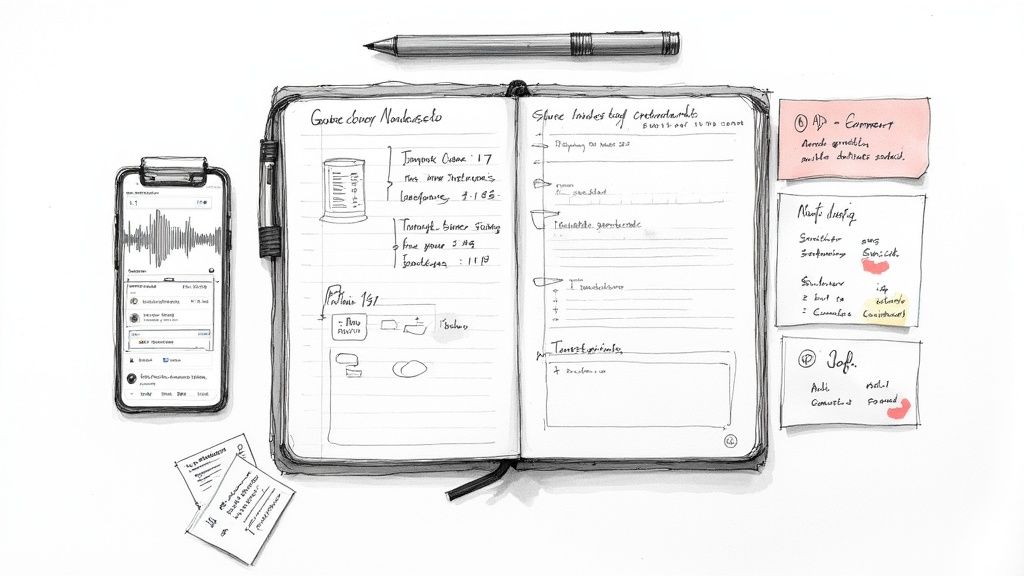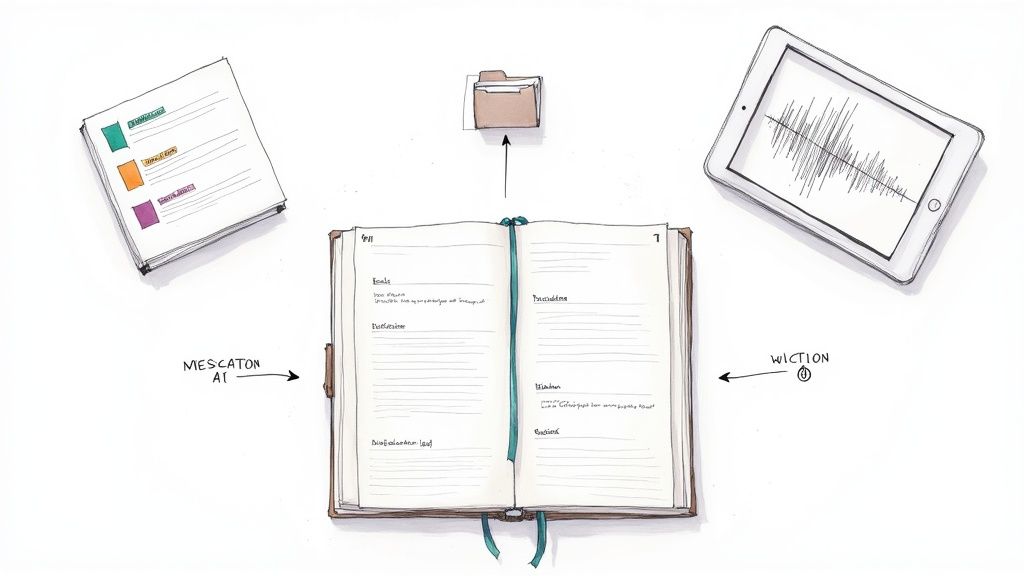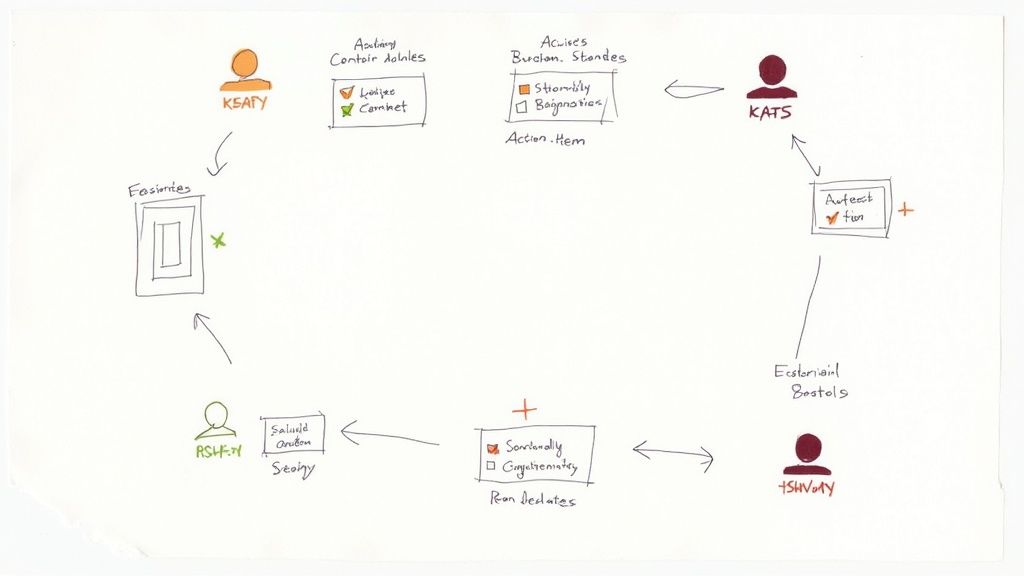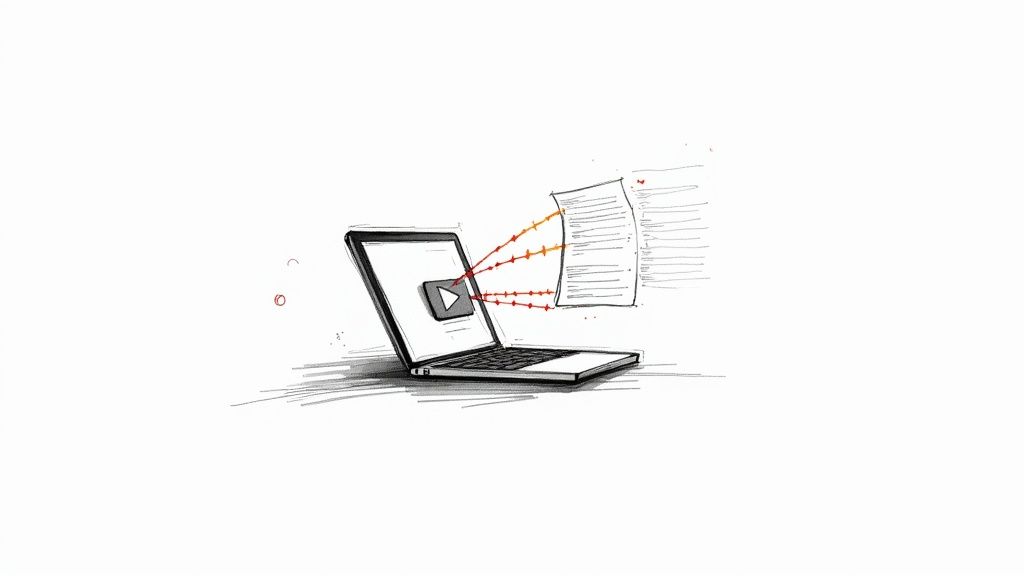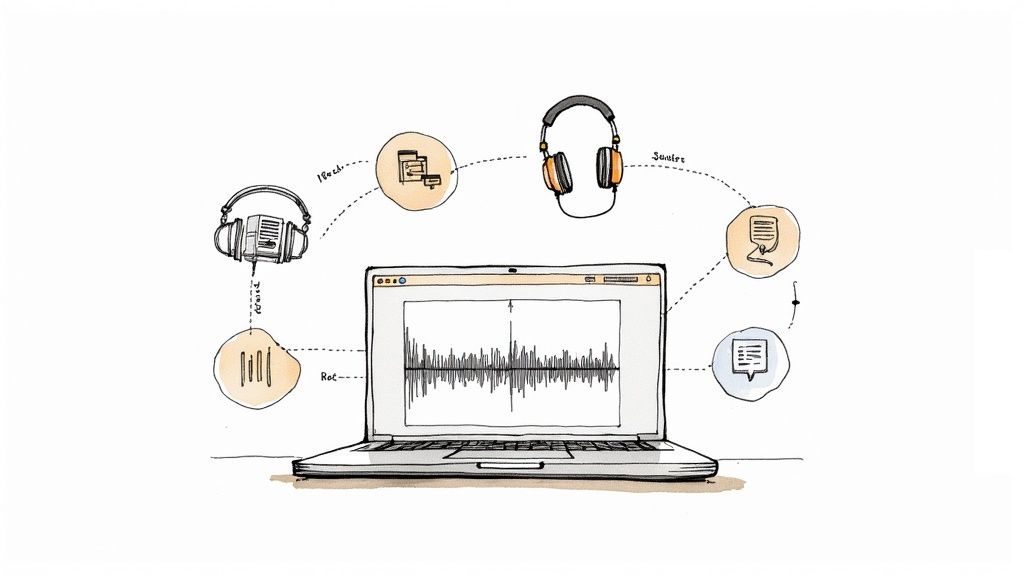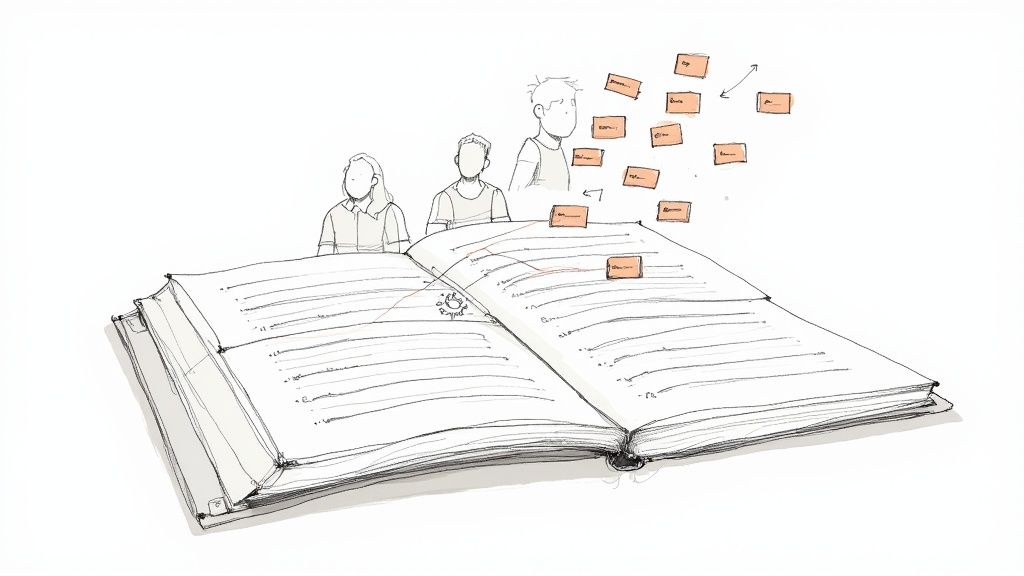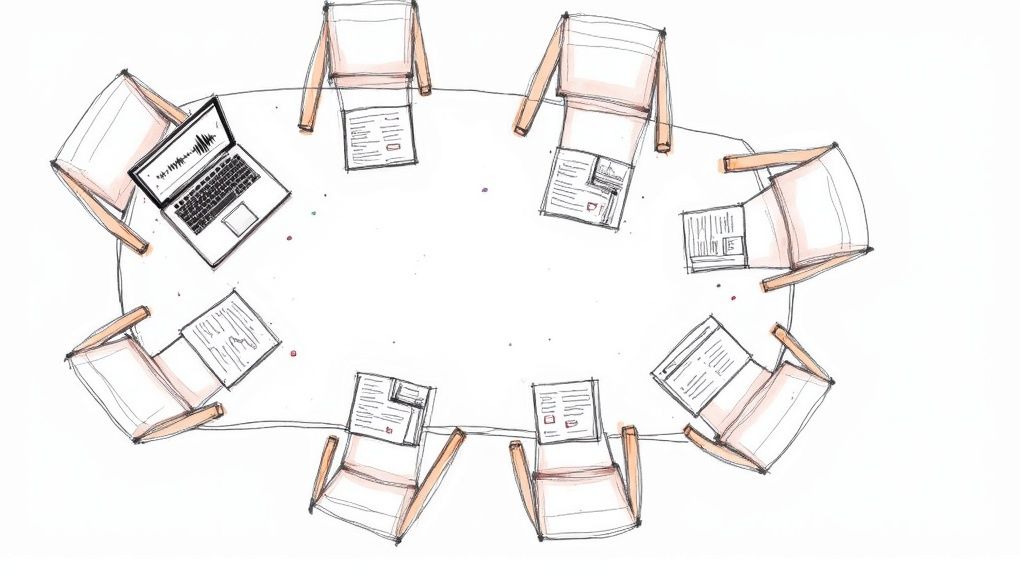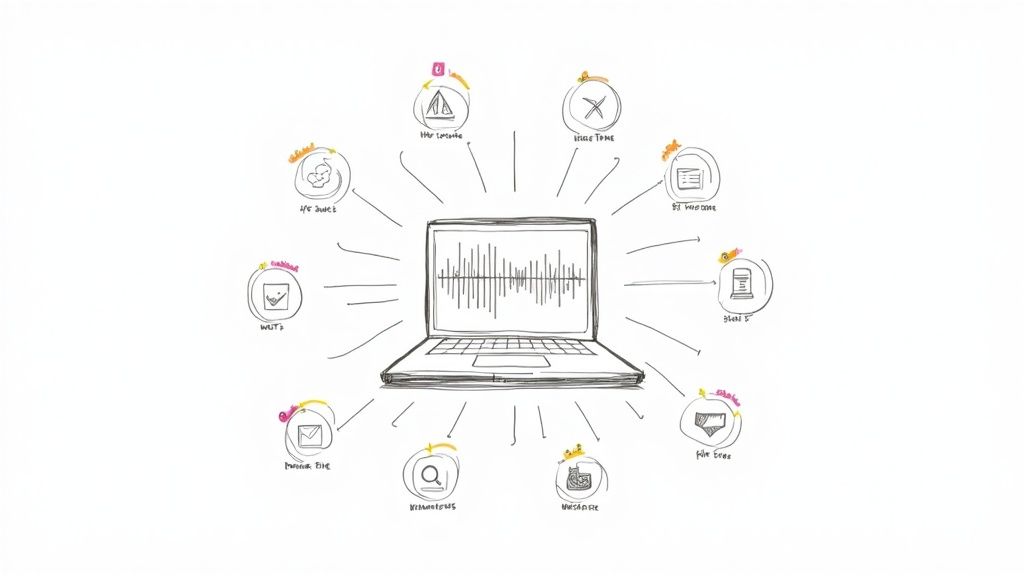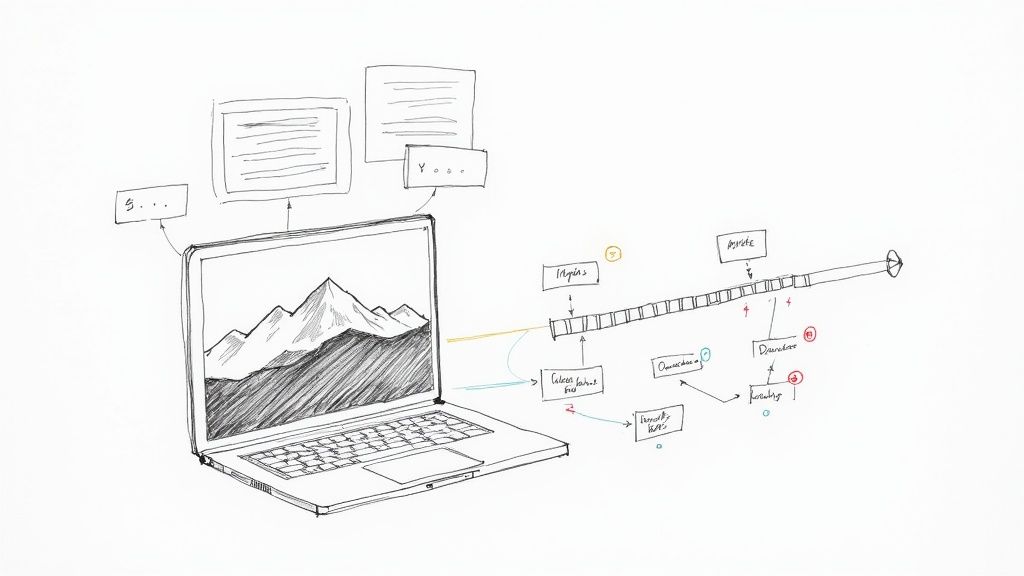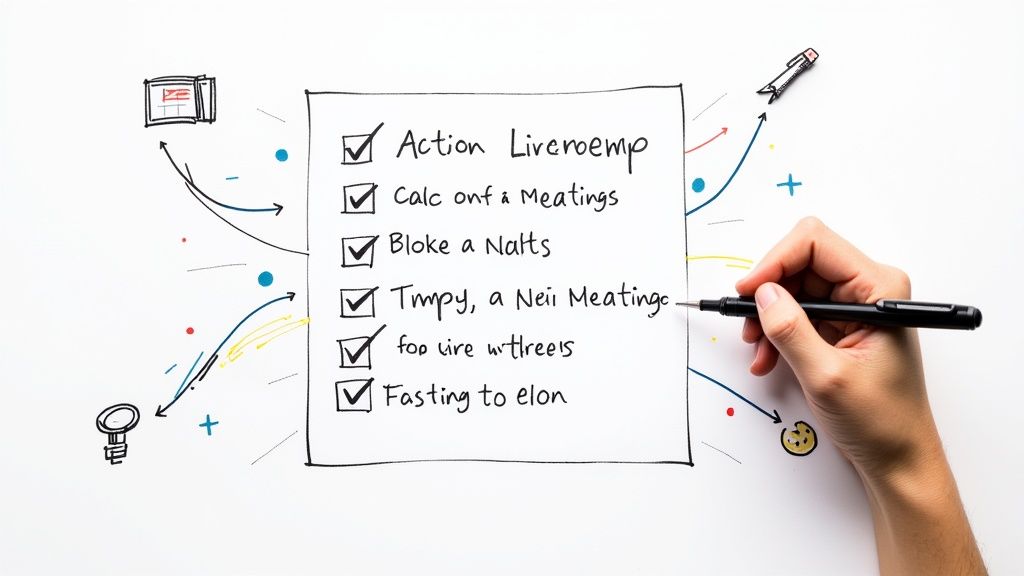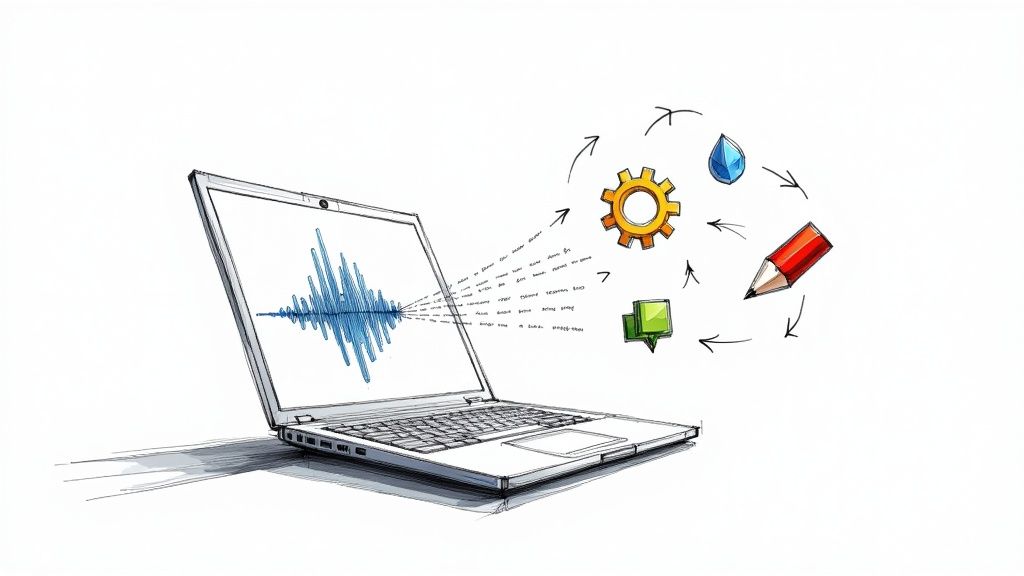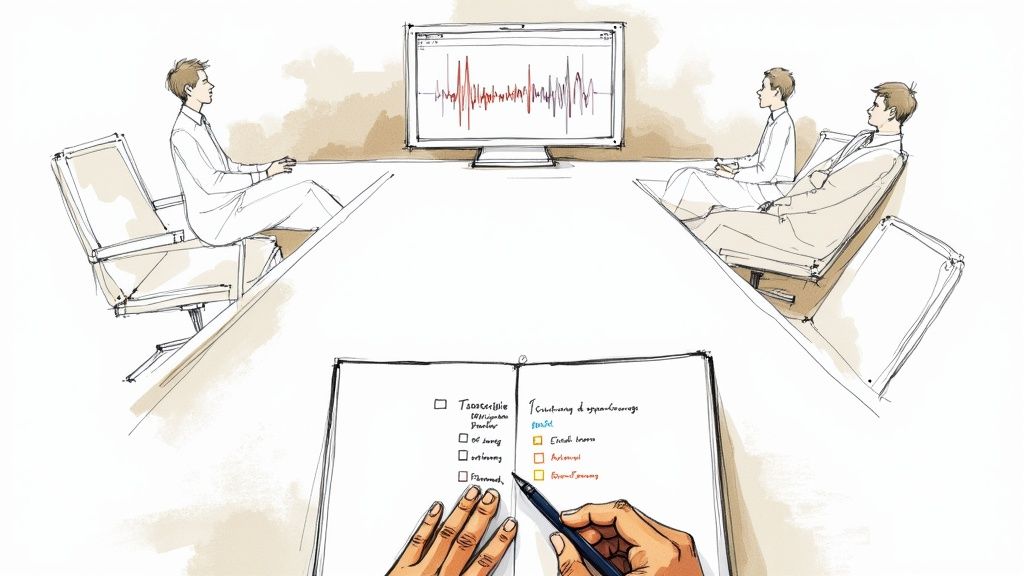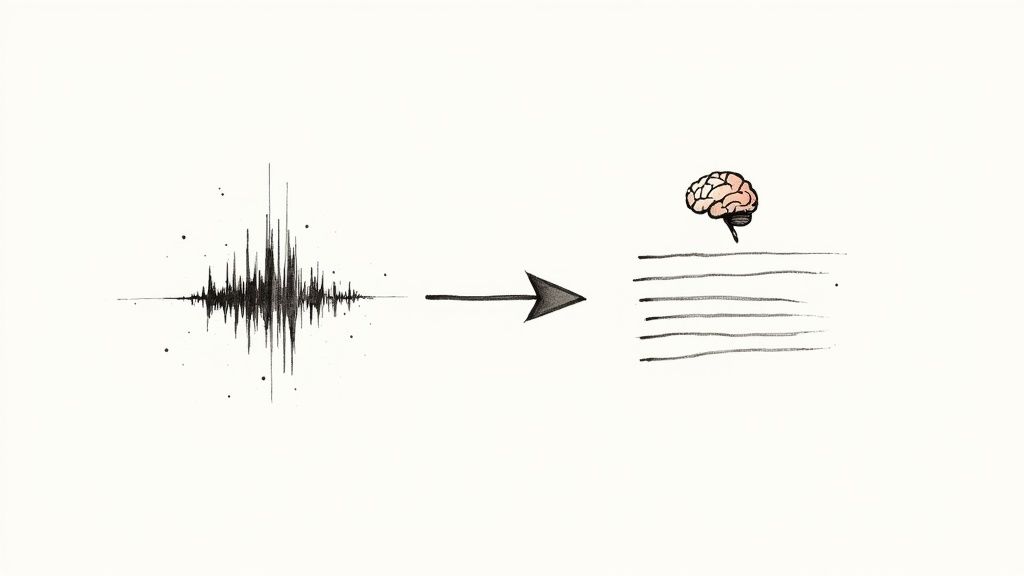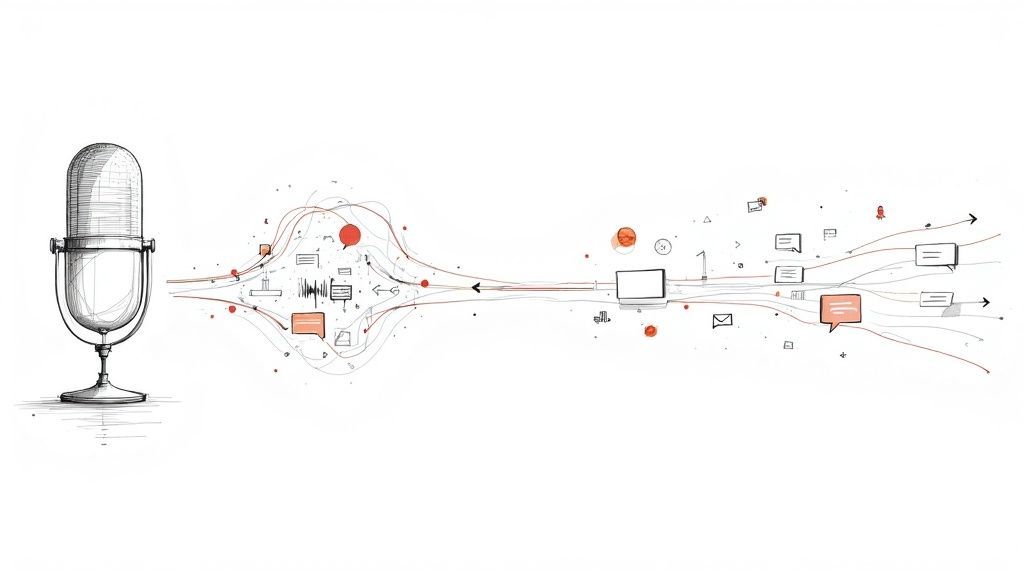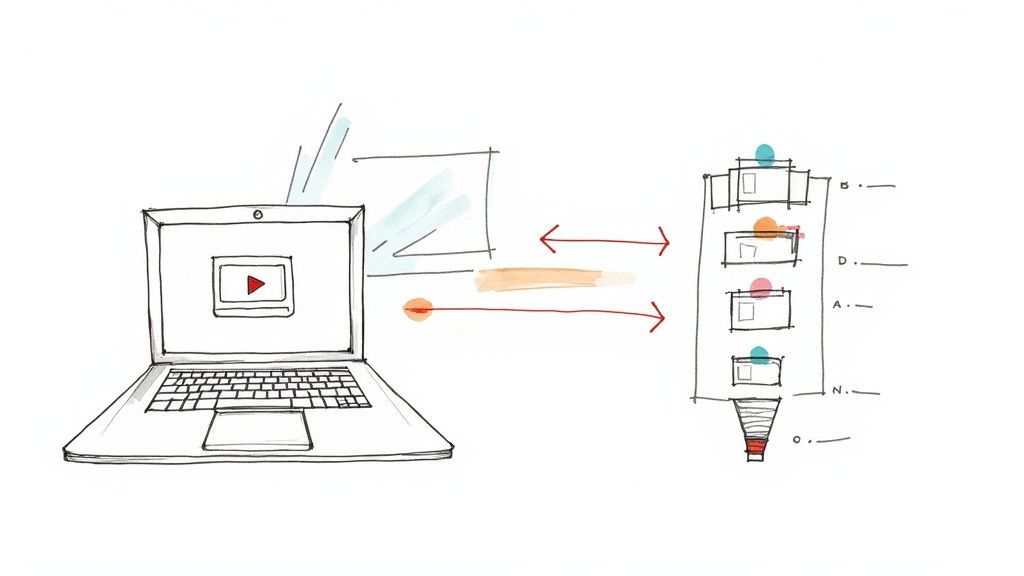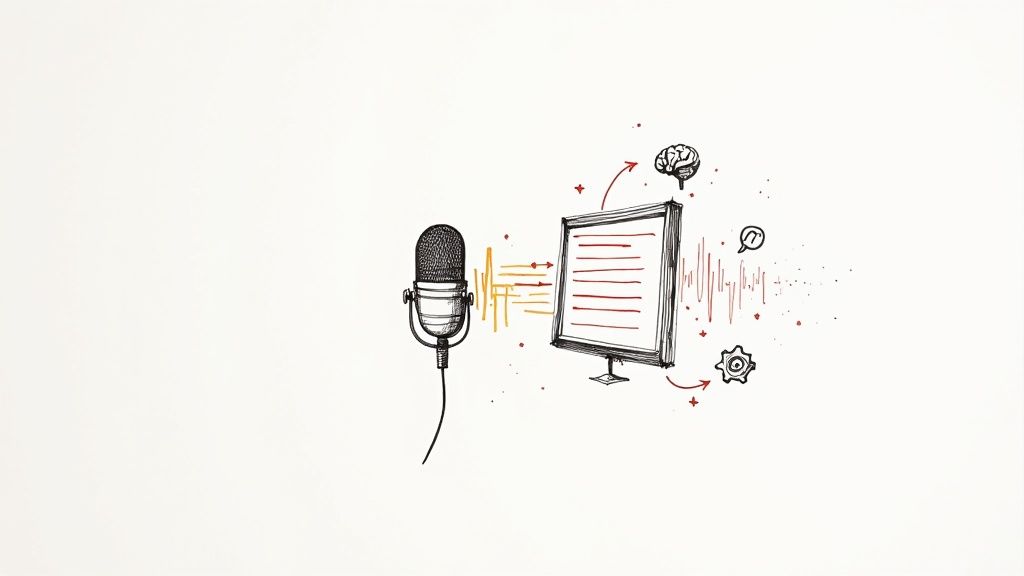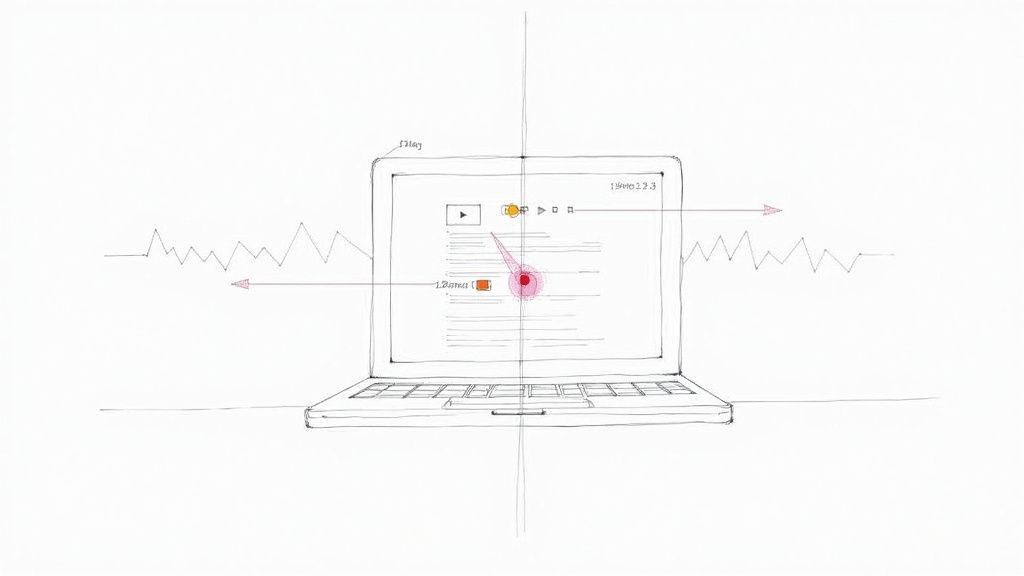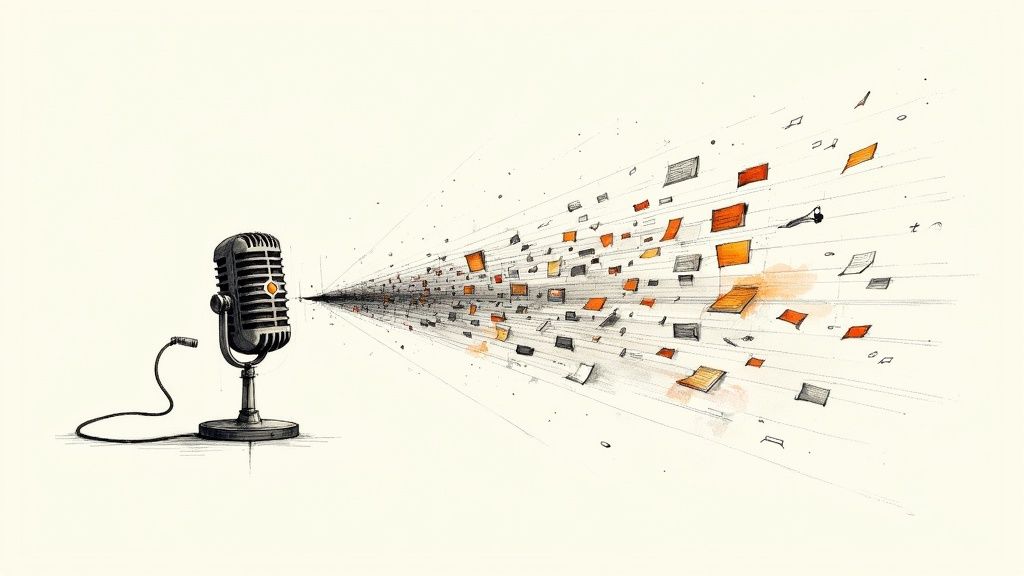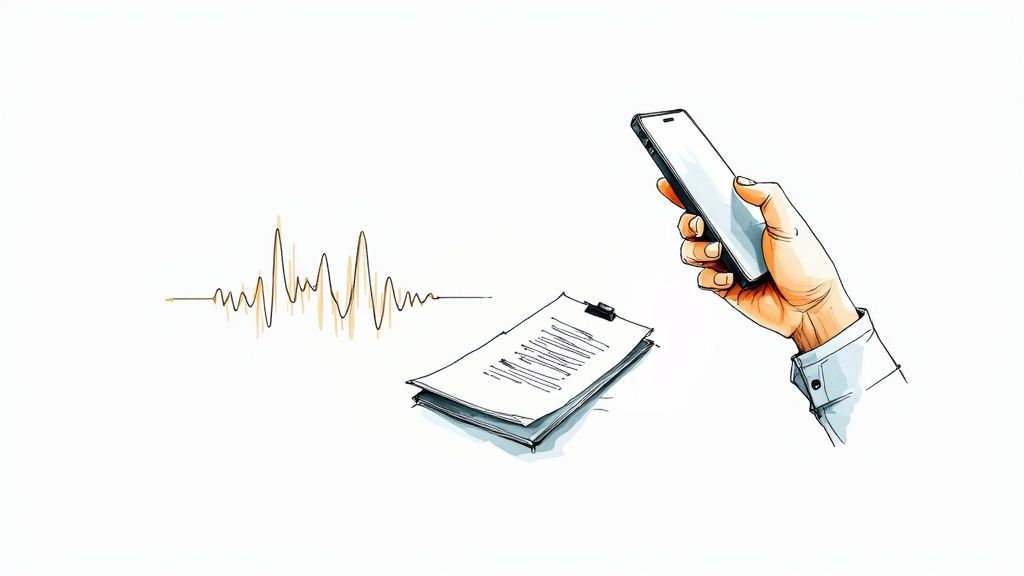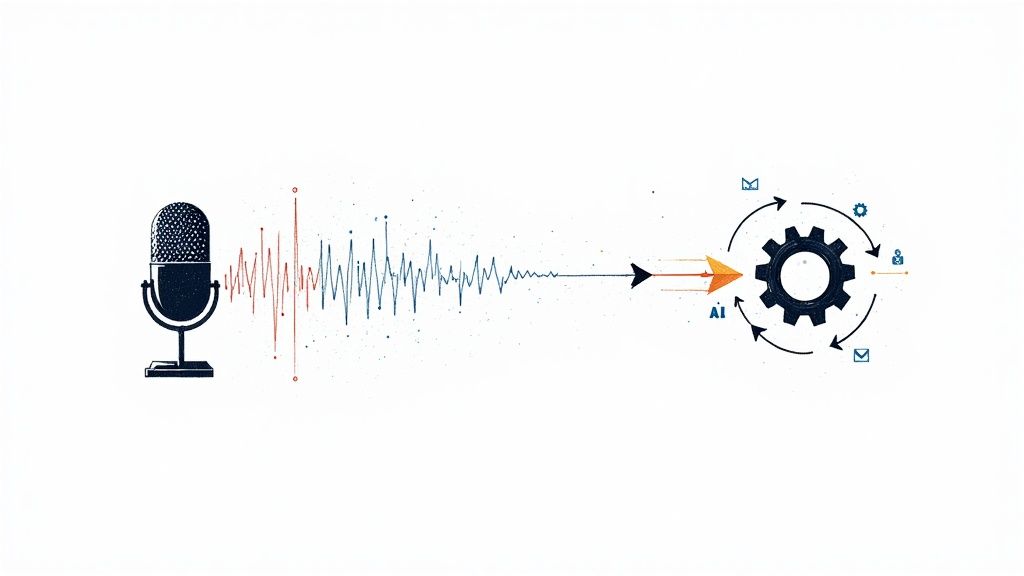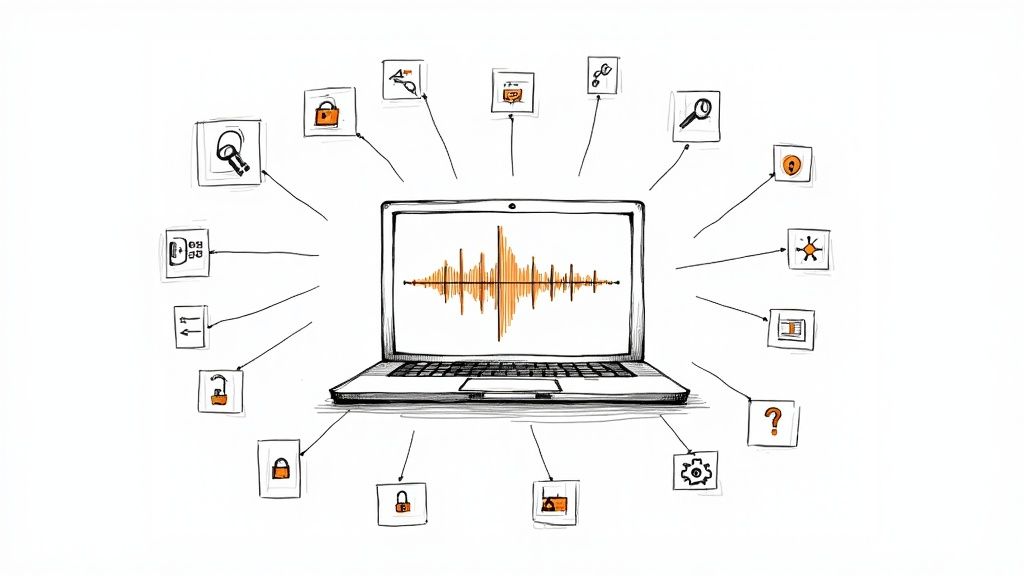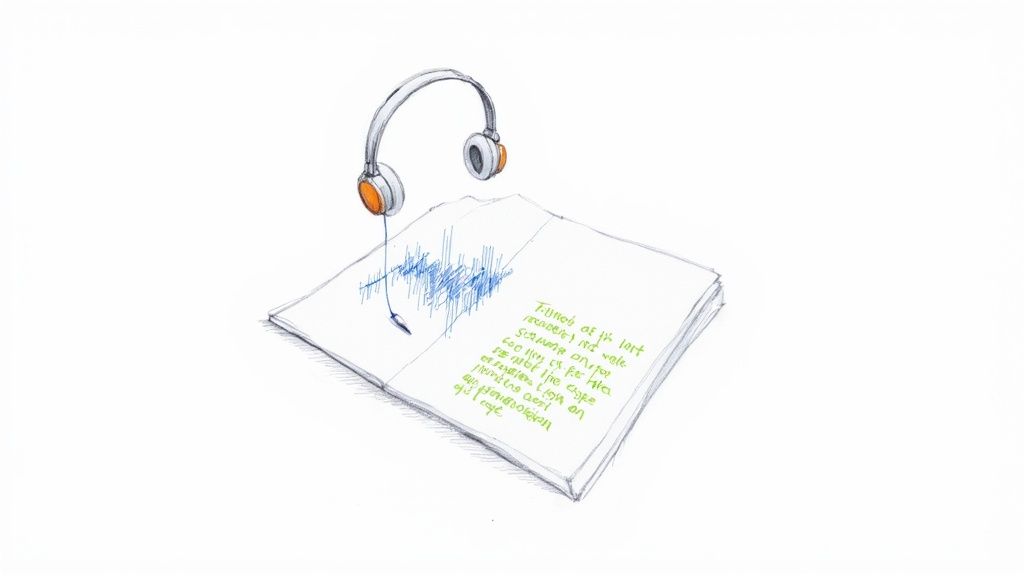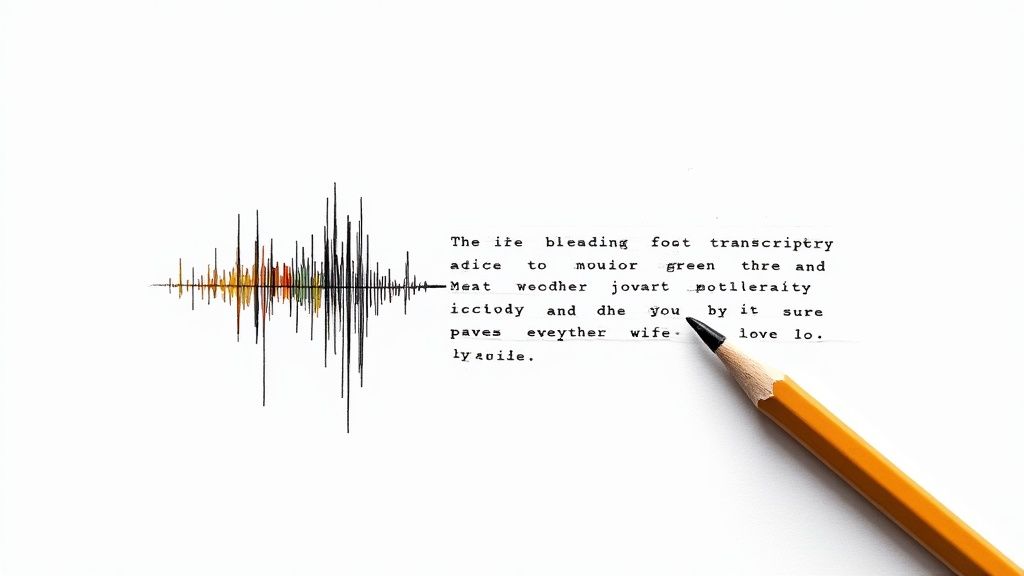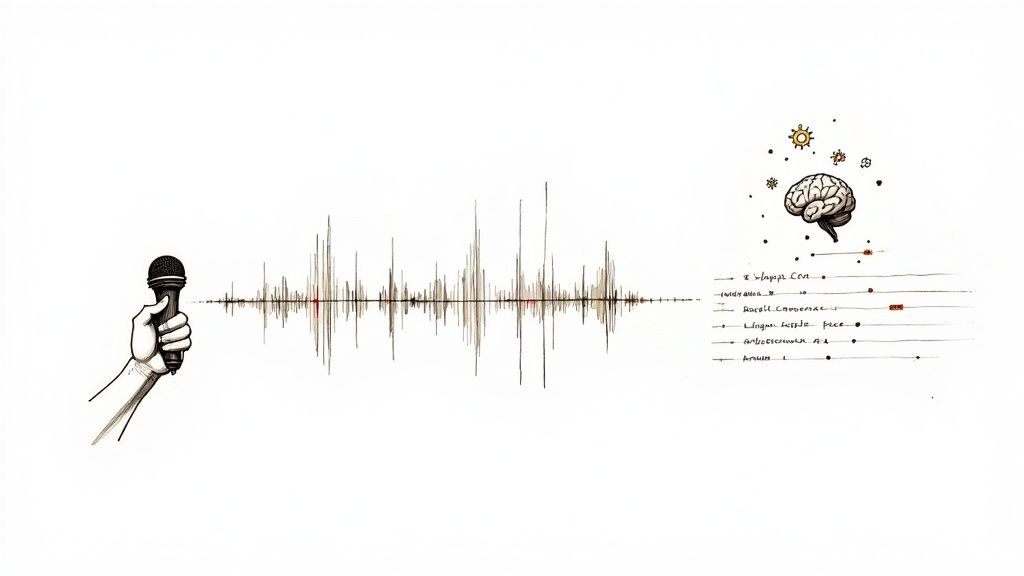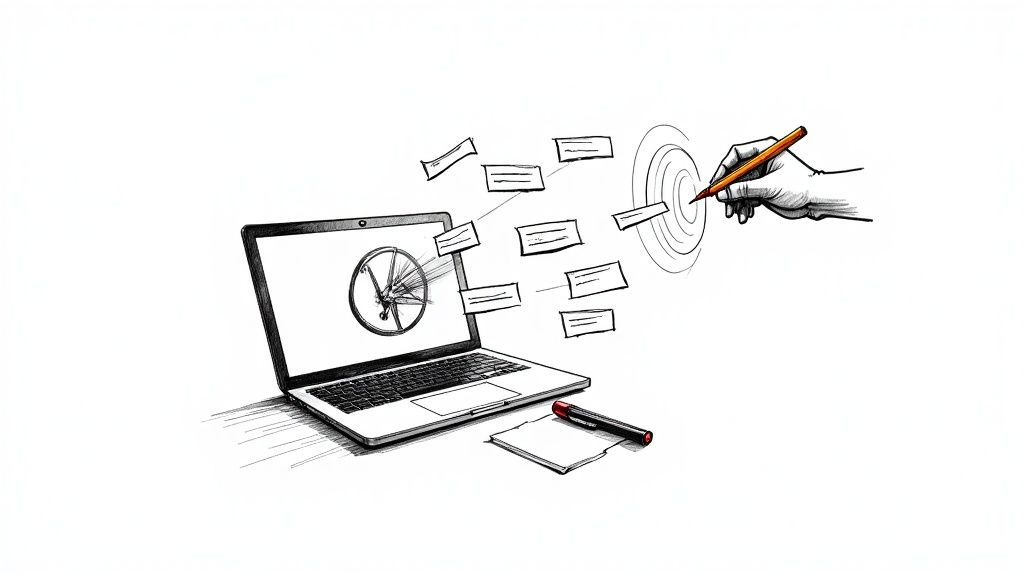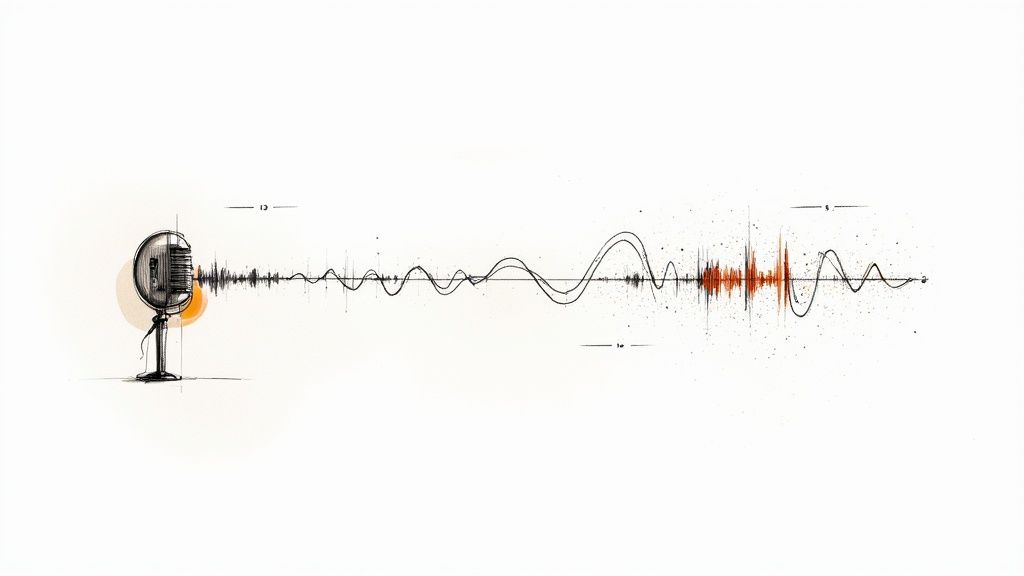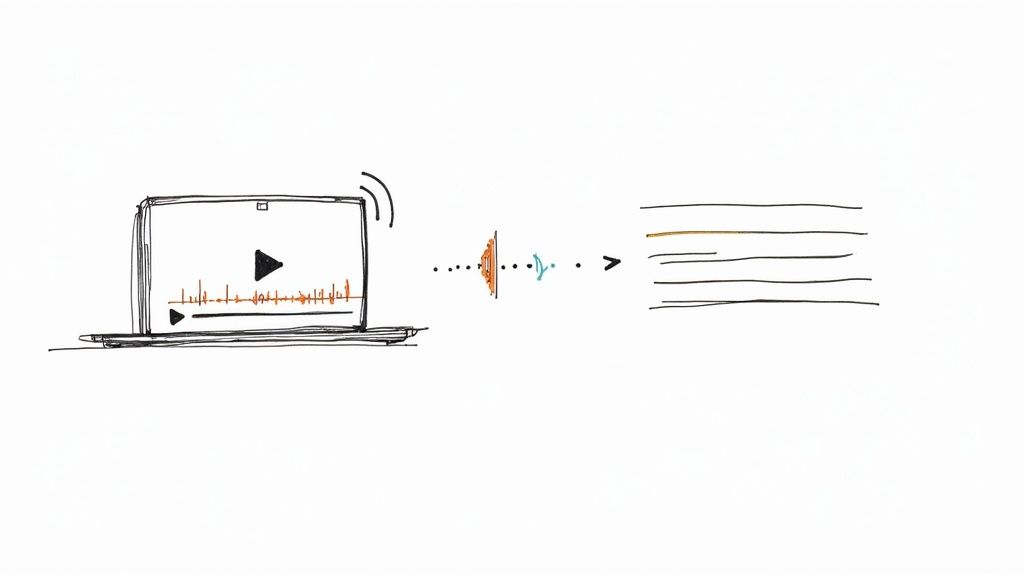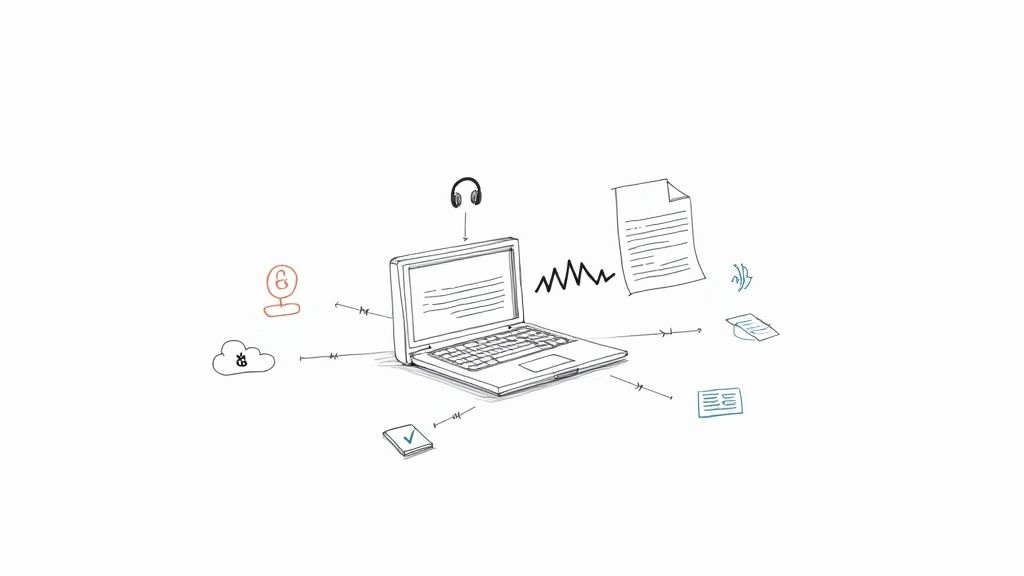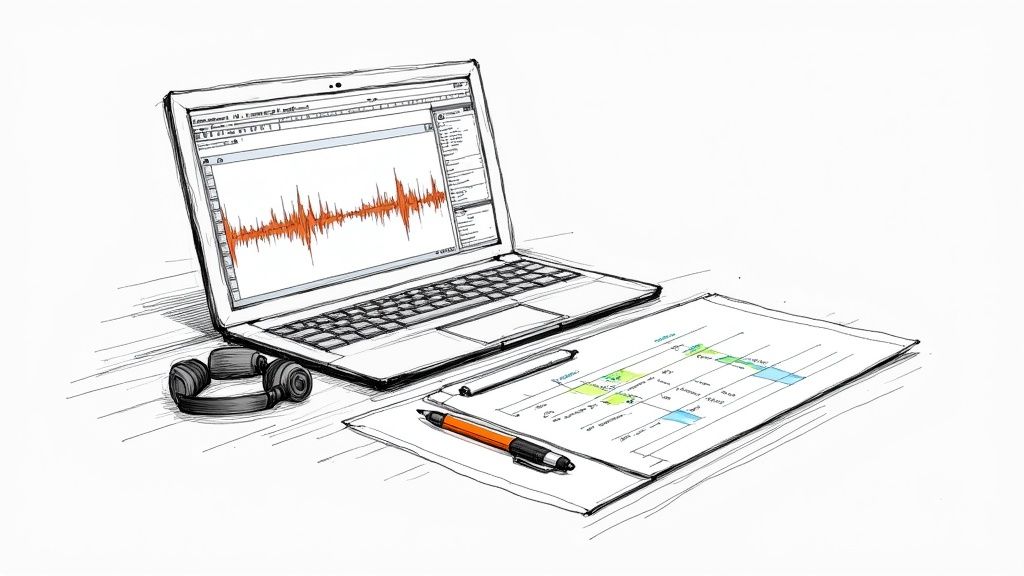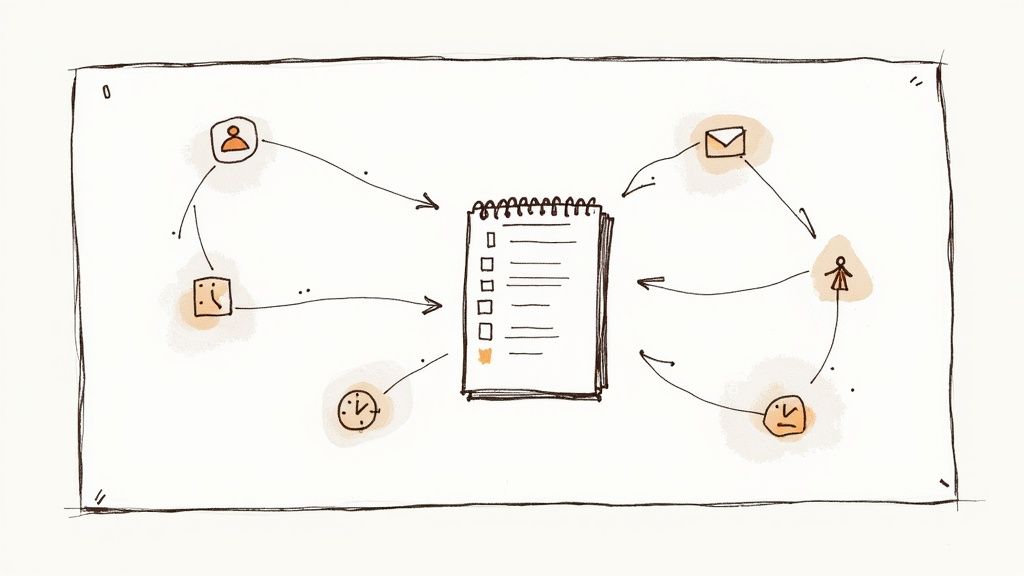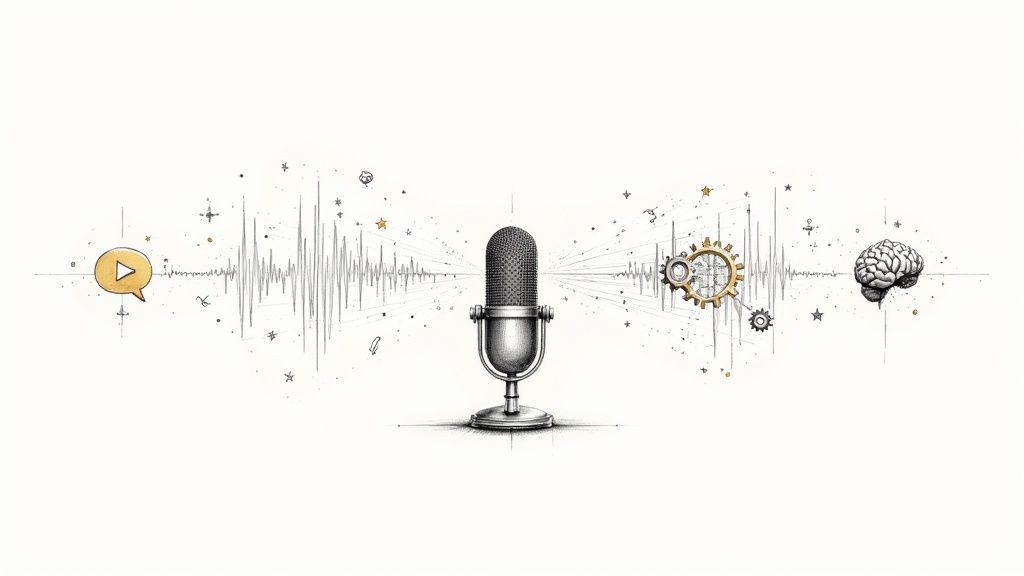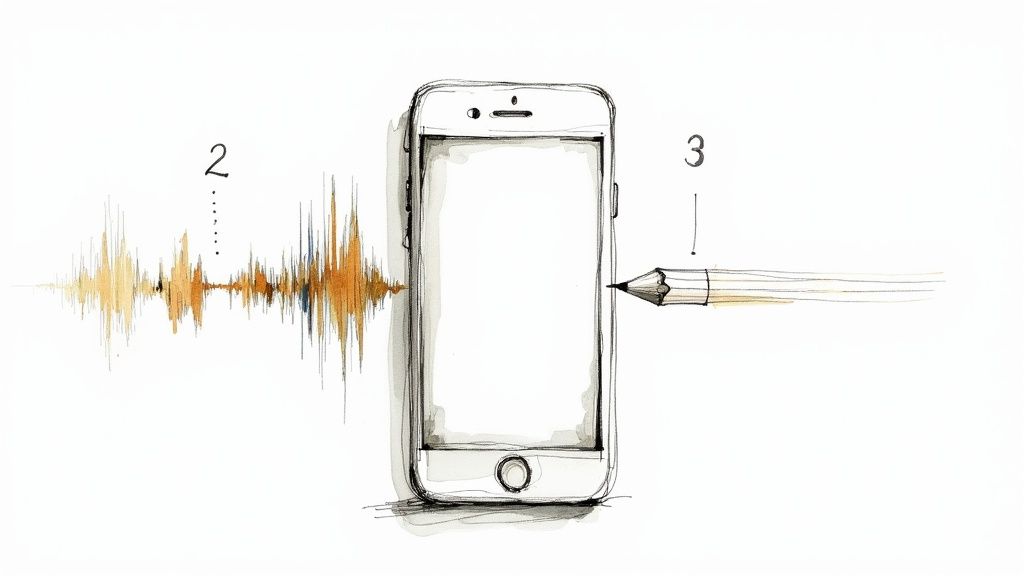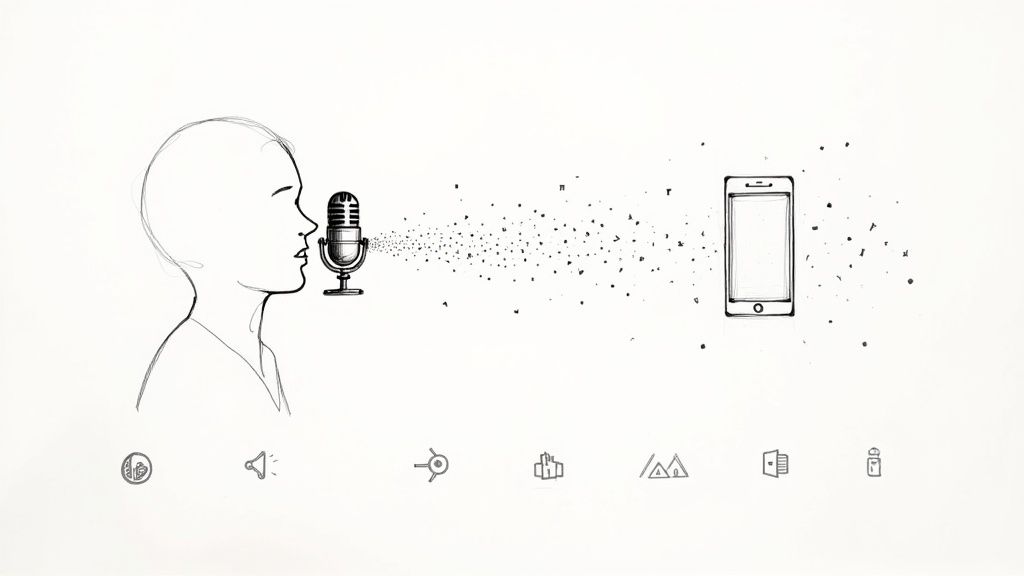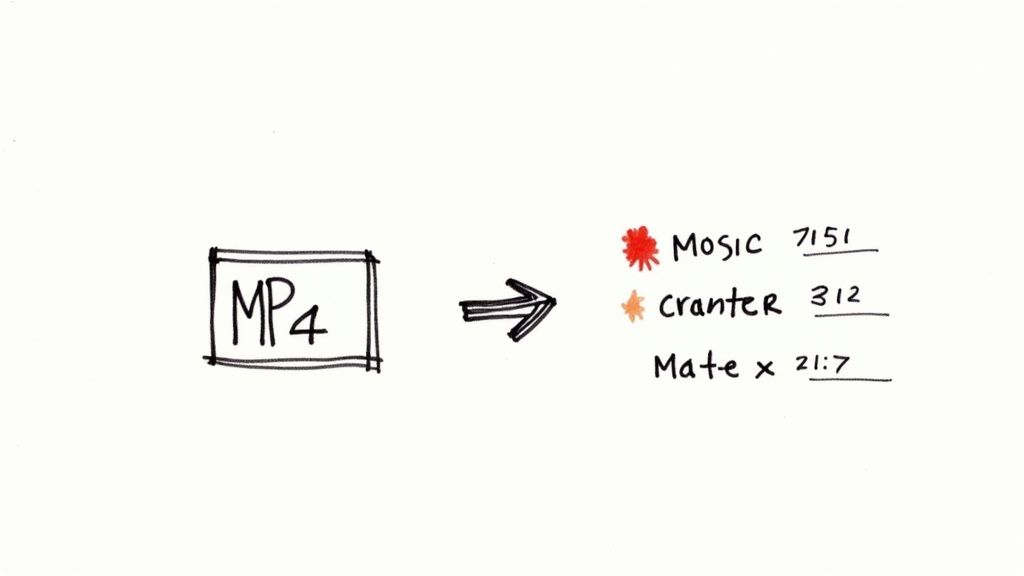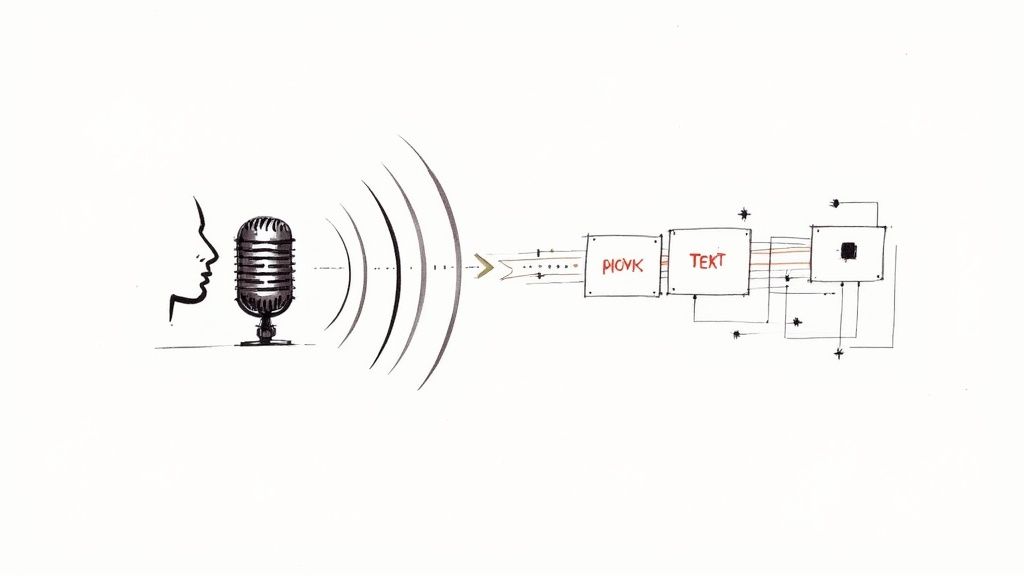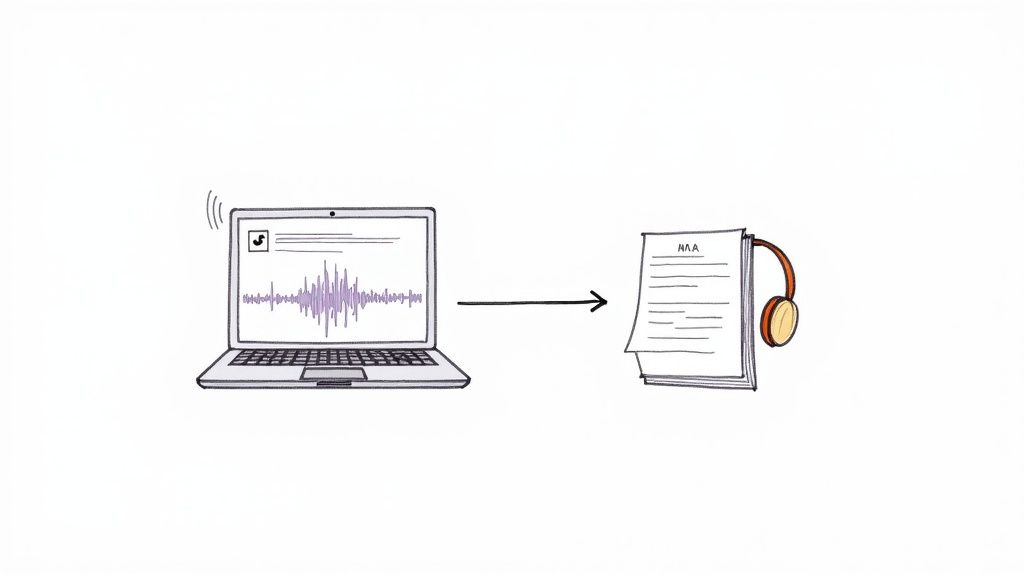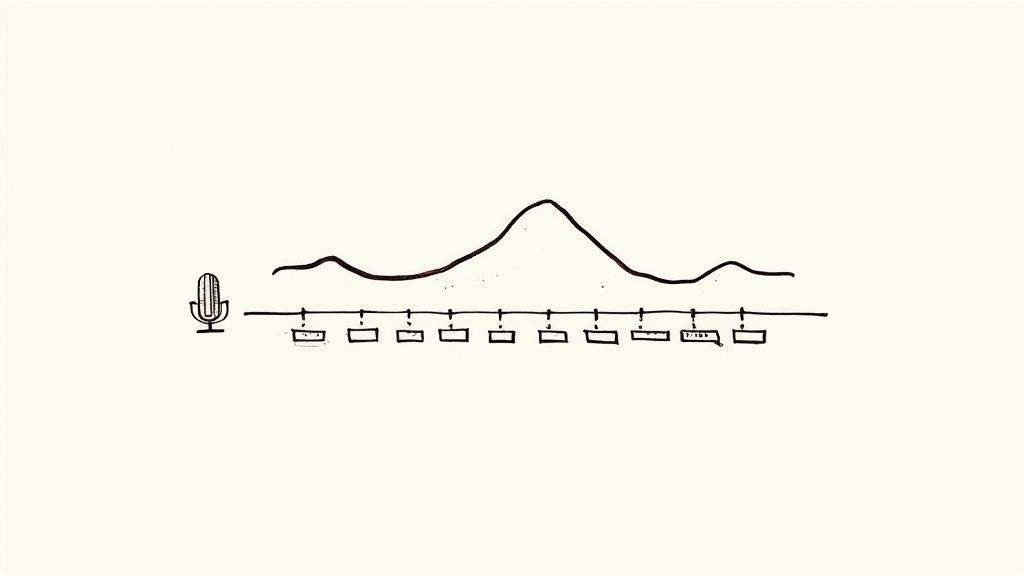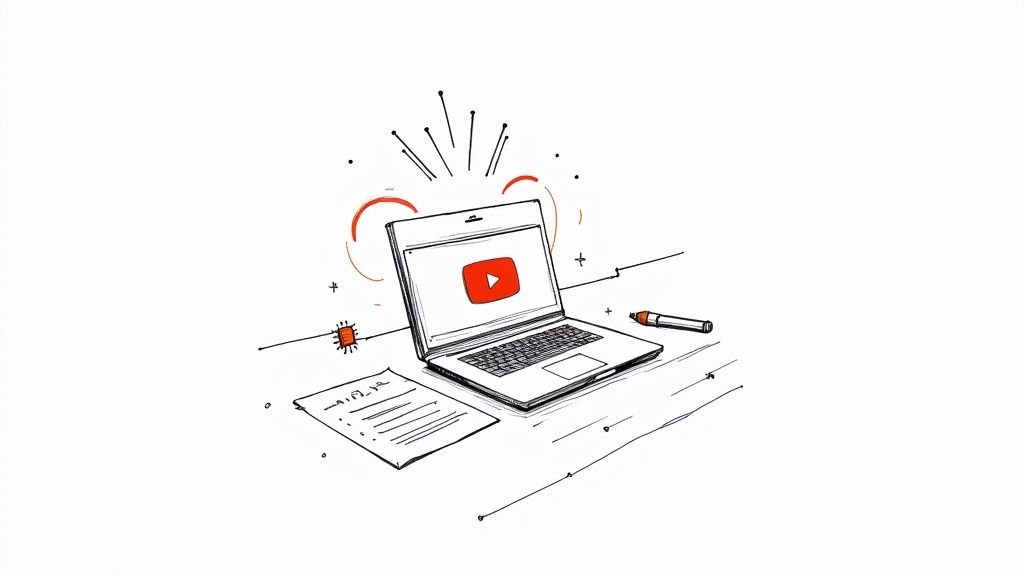
Your Guide to Video Transcription AI
Video transcription AI is the technology that automatically converts the spoken words in a video into a written text file. From my experience using these tools, it’s like having a digital stenographer who listens to your content and types out everything said, often finishing the job in just a few minutes.
What Exactly Is Video Transcription AI?
Imagine a tireless assistant who can sit through hours of your video footage and, almost instantly, produce an accurate, word-for-word script. That's the core of what video transcription AI does. It’s a sophisticated system I've come to rely on, built to translate spoken dialogue into text you can actually search, read, and repurpose.
The traditional method involved a person manually listening and typing, a slow process prone to human error. This technology automates all of that. It uses complex algorithms to recognize speech patterns, assemble them into words, and make sense of sentences. This has made it an indispensable tool for anyone—from content creators to marketers and educators—who needs to get more value out of their video content.
More Than Just Words on a Page
At its core, this technology is powered by machine learning and natural language processing. I find it helpful to think of it like teaching a computer to understand language just as we do. The AI "listens" to countless hours of audio, learning to differentiate between accents, filter out background noise, and even identify who is speaking at any given time.
The more diverse audio data the AI is fed, the sharper and more accurate its transcriptions become. It's this cycle of continuous learning that has made today's video transcription AI so remarkably reliable.
The real magic here is how this technology unlocks the valuable information trapped inside your video files. Once transcribed, spoken words become as searchable, shareable, and versatile as any other written document.
Why This Technology Matters Now
In an age where video is a primary mode of online communication, having a text version of your content isn't just a nice-to-have anymore—it's essential. AI transcription services offer a way to achieve this quickly, affordably, and at a scale previously unimaginable. In my work, they give me the power to:
- Improve Accessibility: Transcripts open up content to people with hearing impairments and non-native speakers.
- Boost SEO: Search engines can't watch a video, but they can easily crawl and index text. This makes content far more discoverable.
- Streamline Content Repurposing: I can effortlessly turn a single video into multiple assets, like blog posts, social media updates, or email newsletters.
In short, video transcription AI takes your dynamic video and gives it the searchability and flexibility of a written document. It’s the key to ensuring every piece of video content you produce reaches its full potential.
How AI Learns to Transcribe Video Content
Have you ever wondered what's happening behind the scenes when you upload a video to a transcription service? It's a fascinating learning process that, in many ways, mirrors how a person learns a language. The journey from raw sound to a clean, readable transcript is a step-by-step affair.
Think about teaching a child to speak. You don’t start with complex grammar. You begin with basic sounds, then words, and eventually, the rules that string them together. AI learns in a strikingly similar way—just at a massive scale and incredible speed.
The Foundational Learning Process
The first step for an AI is to break down the audio into its most basic components. It analyzes sound waves to isolate the fundamental units of speech, known as phonemes. These are the distinct sounds of a language, like the "c" sound in "cat" or the "sh" in "shoe."
By identifying these phonemes, the AI begins mapping out the spoken words phonetically. It then pieces these sounds together, using complex probability models to determine the most likely word. This first step is critical; if the AI misinterprets the phonemes, the entire transcript will be off.
From there, context becomes king. The AI doesn't just listen to words in isolation. It analyzes the surrounding words to understand the sentence's structure and intended meaning. That's how it can differentiate between "write" and "right" or "there" and "their." To dig deeper into how this works, you can check out our guide on voice-to-text AI.
This infographic shows how transcribing a video is the first step in a workflow that boosts accessibility, makes your content searchable, and opens up new ways to repurpose it.

As you can see, a single transcript isn't just a block of text—it's a versatile asset that can serve multiple strategic goals.
Training on Massive Datasets
An AI model is only as good as the data it’s trained on. To achieve high accuracy, these systems are fed enormous datasets—we're talking thousands upon thousands of hours of audio that has been meticulously transcribed by humans. This isn't just any audio, either. The data must be incredibly diverse and cover:
- Accents and Dialects: From a Texas drawl to a Scottish brogue.
- Speaking Styles: Fast talkers, slow speakers, and people with unique intonations.
- Acoustic Environments: Recordings with background chatter, echoes, or even music.
- Specialized Vocabularies: Industry-specific jargon from fields like medicine, law, or tech.
This extensive training builds a robust neural network capable of adapting to the messy, unpredictable nature of real-world audio. The more varied the training data, the better the AI becomes at understanding the subtle nuances of human speech.
AI has completely changed the game for transcription, boosting both speed and precision. Thanks to these powerful algorithms, top-tier tools can now hit accuracy rates of up to 99%. That level of detail is a must-have in fields like media and education, where exact transcripts are non-negotiable. What used to take days of manual work can now be done in minutes, making AI the clear choice for things like real-time captioning.
Advanced Features Demystified
Modern video transcription AI does more than just produce words. It includes sophisticated features that make the final transcript genuinely useful. Two of the most important are speaker diarization and timestamping.
Speaker diarization is the technology that determines who is speaking and when. It's how the AI can label each speaker in a conversation, making transcripts of interviews or panel discussions incredibly easy to read.
Accurate timestamping is the other key piece. The AI aligns every word or phrase with its exact moment in the video. This is essential for creating captions and subtitles, and it lets you jump to specific parts of the video just by clicking on the text. Together, these features transform a simple text file into a structured, searchable, and practical document.
The Real-World Benefits of AI Transcription
Let’s be honest, transcription used to be a real drag. But thinking of video transcription AI as just a way to speed up a tedious task misses the bigger picture. This isn't just about getting words on a page faster; it's about unlocking all the value trapped inside your video files and making that content work much harder for you.
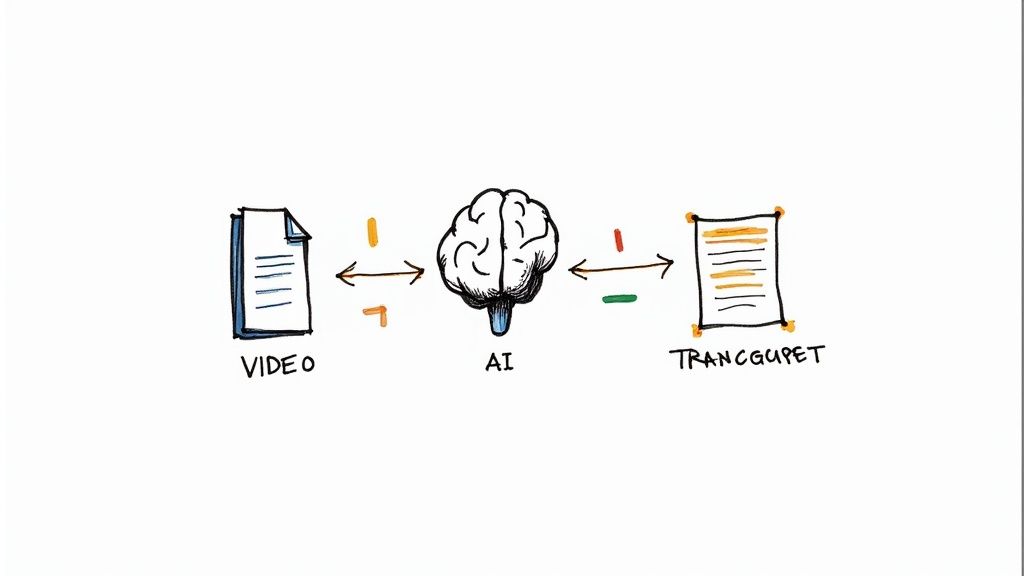
The benefits ripple out across your entire workflow, touching everything from search rankings and audience accessibility to your content strategy as a whole. Let's dig into the practical advantages that make this tech a must-have for modern creators and businesses.
Unlock Your Content for Search Engines
Here’s a hard truth about video: search engines can’t “watch” it. As smart as they are, Google’s crawlers rely on text to figure out what your content is about. That means all the valuable information spoken in your video is effectively invisible to them.
This is where a transcript becomes your secret SEO weapon. By turning all that spoken dialogue into text, you’re essentially handing search engines a keyword-rich blueprint of your content that they can easily crawl and index.
Think of it this way: a transcript is like giving Google the full script to your movie. Suddenly, every single keyword, niche phrase, and key concept you mentioned is fully searchable, radically boosting your chances of ranking for those specific queries.
Imagine you published a tutorial on "advanced photo editing techniques." Without a transcript, Google probably just sees that title. But with a transcript, it sees every expert term you use—like "dodging and burning," "frequency separation," or "color grading"—making your video a perfect match for someone searching for those specific skills.
Make Your Content Accessible to Everyone
Making your content accessible isn't just about ticking a compliance box; it's about reaching a bigger audience. A significant portion of the population has some form of hearing impairment, and even more people watch videos in noisy places like a bus or quiet places like an office.
AI transcription is the simplest solution to this. It provides the text alternatives needed to make your content work for everyone, everywhere.
- Closed Captions: Transcripts are the raw material for accurate captions, letting viewers follow along without sound. In fact, studies consistently show that videos with captions get much higher engagement and longer watch times.
- Non-Native Speakers: For viewers who aren't fluent in the video's language, being able to read along can be the difference between understanding and confusion.
- Meeting Standards: For many schools, government agencies, and public-facing organizations, transcripts are a flat-out requirement for meeting accessibility standards like the WCAG (Web Content Accessibility Guidelines).
When you make your content accessible, you’re not just serving a wider audience—you’re building a more inclusive brand. It's a simple step that ensures no one gets left out of the conversation.
Supercharge Your Content Repurposing
A great video takes a ton of time and energy to produce. It feels like a waste to just publish it once and move on. With a transcript in hand, that one video can become the foundation for a dozen other pieces of content, stretching your ROI further than you thought possible.
A video transcription AI tool is basically giving you a pre-written draft for your next blog post, social media update, or email newsletter. No more re-watching hours of footage just to find a few key quotes.
Just think about how this changes your workflow:
- Video to Blog Post: The transcript is your first draft. Just clean it up, add some headings, and you’ve got a comprehensive article ready to go.
- Interview to Social Snippets: Pull out the most powerful quotes and turn them into shareable graphics for Instagram, LinkedIn, or X.
- Webinar to Email Course: Take the key sections from a webinar and break them down into a multi-part email series, using the transcript to pull the core points for each lesson.
This approach turns content creation from a series of one-off projects into an efficient, interconnected machine. You get way more mileage out of every piece of video you create, keeping your content calendar packed with a fraction of the effort.
Where Video AI Is Making a Real-World Impact
A technology's true worth isn't in what it can do, but in what it's actually doing to solve real problems. For video transcription AI, its influence is already spreading across all sorts of industries, tackling unique challenges and unlocking new possibilities. It's moved beyond being a simple convenience and has become a genuine strategic tool for anyone working with spoken content.
From a fast-paced newsroom to a university lecture hall, automated transcription is proving its value. It helps teams work faster, connect with more people, and pull insights out of video files that were previously locked away. Let's take a look at a few places where this technology is already hard at work.
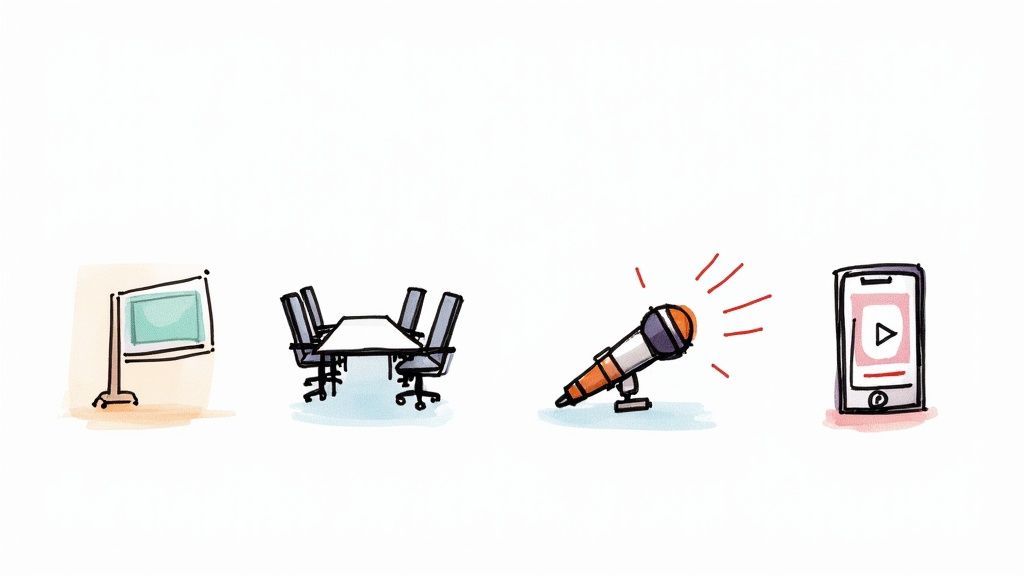
Media and Entertainment
The media world runs on speed. For global broadcasters and creators, manually creating subtitles for a constant firehose of video content was a huge headache. The process was painfully slow and expensive, creating a major roadblock to getting content out to international audiences quickly.
AI transcription completely changed the game. Production houses can now get a highly accurate first draft of a transcript in minutes, not hours. This text is the foundation for creating perfectly timed captions and subtitles, making content ready for global launch in a tiny fraction of the time. For journalists, what used to be hours spent transcribing interviews is now an almost instant process, giving them a searchable text file so they can pull key quotes and get their stories out the door.
Education and E-Learning
The core mission of education is to make learning accessible and effective for everyone. But universities and online course creators were finding it tough to support students with diverse needs. Those with hearing impairments could be left behind, while others struggled to sift through hours of video lectures just to find a single concept for an exam.
By using video transcription AI, educational institutions can now automatically transcribe every single lecture. This has two immediate, powerful benefits:
- Dramatically Better Accessibility: Transcripts offer a text-based version of the lecture for students with hearing disabilities, helping schools meet crucial accessibility standards.
- Smarter Study Tools: Students can now search a transcript for a specific keyword and jump right to the moment it was mentioned in a video. It makes studying so much more efficient.
This one change turns a passive video lecture into a dynamic, searchable study guide.
When you convert spoken lessons into text, you're giving students the power to learn on their own terms. The transcript becomes a tool for review, research, and deeper understanding, creating a more level playing field for everyone.
Marketing and Market Research
Marketers live and die by the "voice of the customer." They pour resources into interviews, focus groups, and webinars to get that qualitative data. The big problem? Manually digging through hours of recordings was a slow, subjective nightmare. So many valuable insights and direct customer quotes were just getting lost in the shuffle.
With AI transcription, that whole process gets an upgrade. Marketers can upload recordings from customer calls or webinars and get a full transcript back in no time. They can then analyze this text for common themes, specific keywords, and customer sentiment. A marketing team can instantly pinpoint the exact words customers use to describe their problems—gold for writing ad copy that actually connects. It replaces guesswork with real evidence from real conversations. For example, by analyzing what people say, you can learn how to transcribe YouTube videos to better understand viewer feedback and create content they love.
To see this in action, here's a quick look at how different fields are putting AI transcription to work.
Impact of Video Transcription AI Across Industries
IndustryPrimary Use CaseKey BenefitMedia & EntertainmentCreating subtitles and closed captions for global distribution.Speed & Scalability - Dramatically reduces production time.EducationMaking lectures accessible and creating searchable study materials.Inclusivity & Efficiency - Improves learning for all students.MarketingAnalyzing customer interviews and webinar recordings for insights.Data-Driven Decisions - Uncovers customer sentiment and language.LegalTranscribing depositions, witness statements, and court proceedings.Accuracy & Searchability - Creates a precise, searchable record.HealthcareDocumenting patient consultations and medical lectures.Improved Documentation - Frees up practitioners from note-taking.
As you can see, the applications are incredibly diverse. The common thread is turning spoken audio—which is hard to search and analyze—into text, which is structured, accessible, and full of potential.
Choosing the Right AI Transcription Tool
With so many AI transcription tools out there, picking the right one can feel like a shot in the dark. It’s easy to get bogged down by marketing hype, but the secret is to focus on what actually matters for your work. A tool that’s perfect for a journalist transcribing interviews is probably overkill for a social media manager creating quick captions.
The goal isn't to find the one "best" tool on the market, but the right tool for you. You need a solid way to compare services based on the things that will make or break your workflow: accuracy, key features, security, and of course, price.
Evaluating Core Transcription Features
Before you even think about signing up, you have to look at the practical, hands-on features that turn a wall of text into something genuinely useful. This is where the real time-savings happen, and not all platforms are created equal.
Here are the make-or-break features you should be looking for:
- Accuracy Rates: A lot of services boast high accuracy, but the number doesn't mean much until you test it on your own content. Aim for a baseline of 90% or higher, but always run a trial with your own files. Does it handle background noise, multiple speakers, or the specific jargon you use every day?
- Speaker Identification (Diarization): This is an absolute must-have for anyone transcribing interviews, meetings, or podcasts. It automatically figures out who said what and when, saving you from the soul-crushing task of manually labeling speakers.
- Multi-Language Support: If you have a global audience or work with international content, this is non-negotiable. See if the tool can handle different languages, but also dig deeper to see how it performs with various accents and dialects.
- Timestamping: Essential for creating captions and subtitles. This feature locks every word to its precise moment in the video, making it a breeze to jump between the transcript and the video timeline.
Getting clear on these features will help you cut through the noise. For a deeper dive, our guide on the best software to transcribe video breaks down some of the top options.
Understanding Security and Privacy
When you upload a video, you're handing over your content to a third party. That's a big deal, especially if you're working with sensitive material like internal company meetings, confidential client interviews, or unreleased media.
Make sure you read the fine print on a provider's security protocols. Look for concrete commitments to data encryption, both when you're uploading and when your files are stored on their servers. A clear, straightforward privacy policy is also a great sign—it should explicitly state that your data won't be used to train their AI models unless you say it's okay.
Your content is your intellectual property. The right AI tool should act as a secure processor, not a co-owner of your data. Prioritize services that are transparent about their security measures and compliance with standards like GDPR.
Comparing Pricing Models
AI video transcription costs can be all over the map, and the way you're billed can have a huge impact on your budget. It usually boils down to two main approaches: paying as you go or signing up for a subscription.
- Pay-As-You-Go (Per-Minute): This is your best bet if you only need to transcribe videos every now and then. You pay for exactly what you use, making it incredibly cost-effective for one-off projects or unpredictable workloads.
- Subscription Plans: If you're transcribing videos consistently every month, a subscription is almost always the smarter financial move. These plans give you a block of hours for a flat monthly fee, and the per-minute rate is usually much, much lower.
The best way to decide is to estimate how many minutes or hours you'll need transcribed each month. A little bit of simple math will show you which model saves you more money. And never underestimate the power of a free trial—it's the perfect way to test-drive a service's accuracy and features before you pull out your credit card.
What's Next for Automated Transcription?
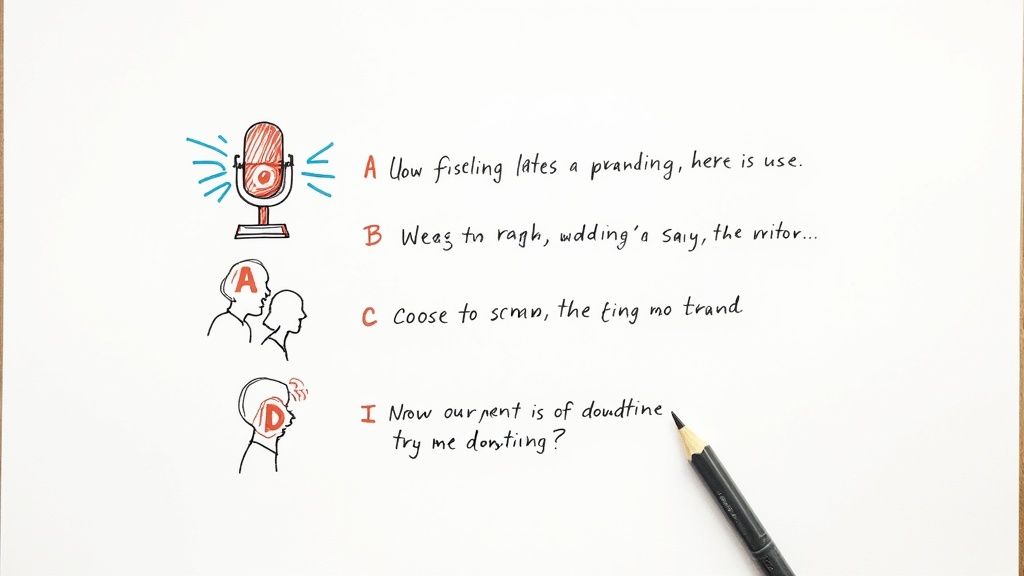
What we're seeing now with video transcription AI is just the beginning. The technology is getting smarter every day, and the next few years are going to bring changes that make our current tools feel like relics. We’re moving from AI that just hears words to AI that genuinely understands context, emotion, and intent.
And it’s not just a niche interest; the demand is enormous. The global market for AI transcription is expected to jump from $4.5 billion in 2024 to an incredible $19.2 billion by 2034. That’s a 15.6% compound annual growth rate, a clear signal that businesses everywhere are betting big on this technology. You can dig into the numbers in this AI transcription market growth report from Market.us.
Real-Time Transcription and Instant Translation
One of the most powerful developments is the push for flawless, real-time transcription and translation. Picture this: you're hosting a live global webinar, and as you speak, attendees in Japan, Germany, and Brazil are all reading accurate captions in their own languages. Instantly.
This isn't science fiction anymore. It’s about to completely tear down language barriers, making global communication feel truly effortless. For anyone running live events, streaming content, or managing an international team, this means everyone can be on the same page, at the same time.
Moving Beyond Words to True Understanding
The real leap forward is in the AI's ability to analyze how something is said, not just what is said. Think of it as adding new layers of intelligence on top of the raw text. Two areas, in particular, are set to change the game: sentiment analysis and automated summaries.
The future isn't just about getting a perfect script; it's about getting a summary of the script, an analysis of its emotional tone, and a list of key takeaways, all generated automatically.
This is a huge shift. Instead of spending hours sifting through video, you’ll get the critical insights handed to you. Here's what that looks like in practice:
- Automated Summary Generation: An AI will be able to take a two-hour board meeting or a dense university lecture and boil it down into a sharp, concise summary with key bullet points. You get the essential information without having to watch a single frame.
- Sentiment Analysis: This is all about detecting the emotion behind the words. The AI can tell you if a customer in a feedback call is frustrated, if an audience in a focus group is excited, or if the tone of a meeting is positive or tense. That’s incredibly valuable data for everything from product development to HR.
When you put these capabilities together, you’re not just transcribing video anymore. You’re turning every recording into a goldmine of actionable intelligence, with the AI doing the heavy lifting to find the gold for you.
Frequently Asked Questions
Even after you've got a good handle on AI video transcription, some practical questions always pop up. Let's get into a few of the most common ones that people ask when they're starting out.
How Does AI Transcription Stack Up Against a Human?
This is the big one, right? The honest answer is: it depends on what you need.
Top-tier AI transcription services can hit accuracy levels of 95% or even higher, which is incredibly impressive. But a skilled human transcriber will almost always catch the subtle nuances better—things like sarcasm, thick accents, or conversations happening over a lot of background noise.
The real game-changer with AI is speed and cost. You can get a transcript back in a few minutes, not a few days, and for a fraction of the price of a manual service.
What we see working best for many people is a hybrid approach. Let the AI do the initial, heavy-lifting transcription in minutes. Then, have a person give it a quick once-over to catch any small errors and refine the text. You get the best of both worlds: the speed of a machine and the final polish of a human expert.
Can AI Actually Handle Messy, Real-World Audio?
You'd be surprised. The latest video transcription AI has gotten really good at dealing with audio that isn't crystal clear. These systems are trained on massive, diverse datasets, so they've "heard" it all before.
- Background Noise: Modern AI is trained to distinguish a human voice from things like cafe chatter, passing traffic, or background music, and can often isolate the dialogue.
- Multiple Speakers: Good platforms use a technology called speaker diarization. This allows the AI to tell who is speaking and when, labeling the transcript accordingly, even if people are talking over each other.
- Accents and Industry Jargon: The more data an AI is trained on, the better it gets. The best tools have been exposed to a huge range of accents, dialects, and even niche, industry-specific terms, making them far more versatile.
Is My Video Data Kept Private and Secure?
This is a non-negotiable, especially if you're working with sensitive or confidential material. Any reputable AI transcription company will take security very seriously.
Think of it this way: your video content is your intellectual property. The service you use should treat it that way. Look for providers who use strong encryption for your files, both when they're being uploaded and while they're stored on their servers.
Dig into their privacy policy. You want to see a clear statement that your data won't be used to train their AI models without your direct permission. Always go with a service that’s transparent about its security measures and complies with data protection laws like GDPR. It’s the only way to ensure your information stays private.
Ready to see what AI can do for your video content? Whisper AI delivers incredibly fast and accurate transcriptions and summaries in over 92 languages. It's time to stop the manual grind and start working smarter. Get started with Whisper AI for free!
